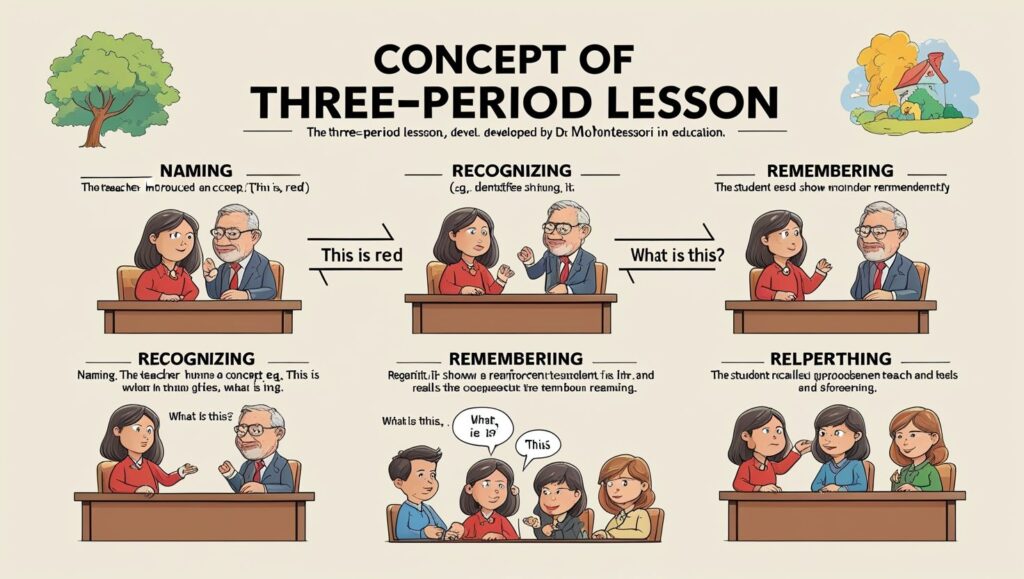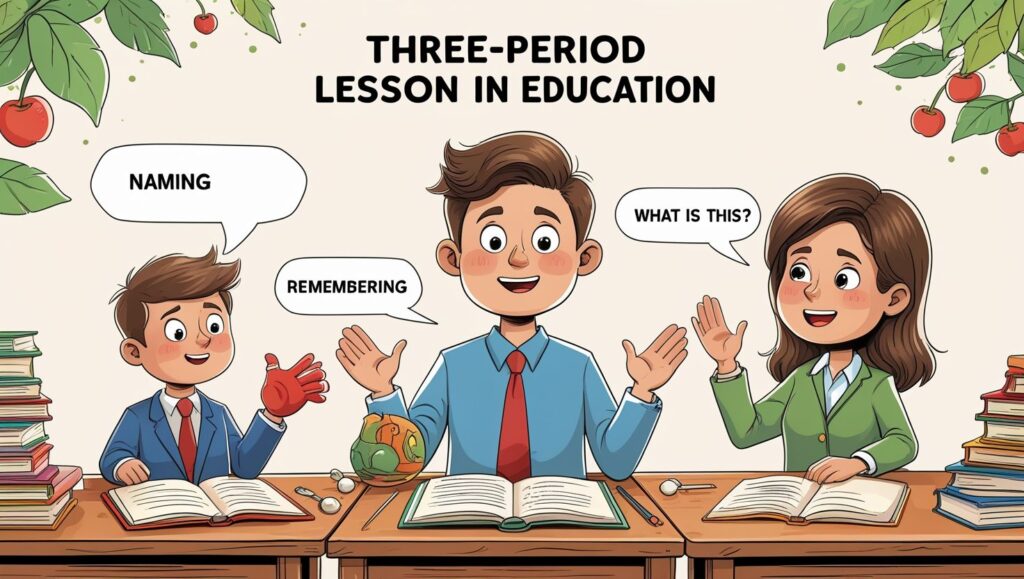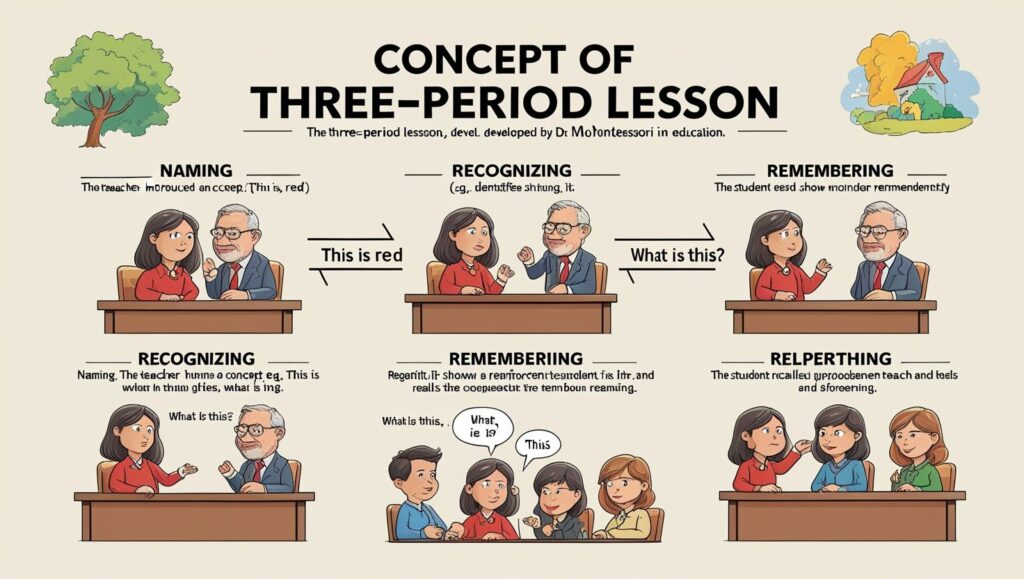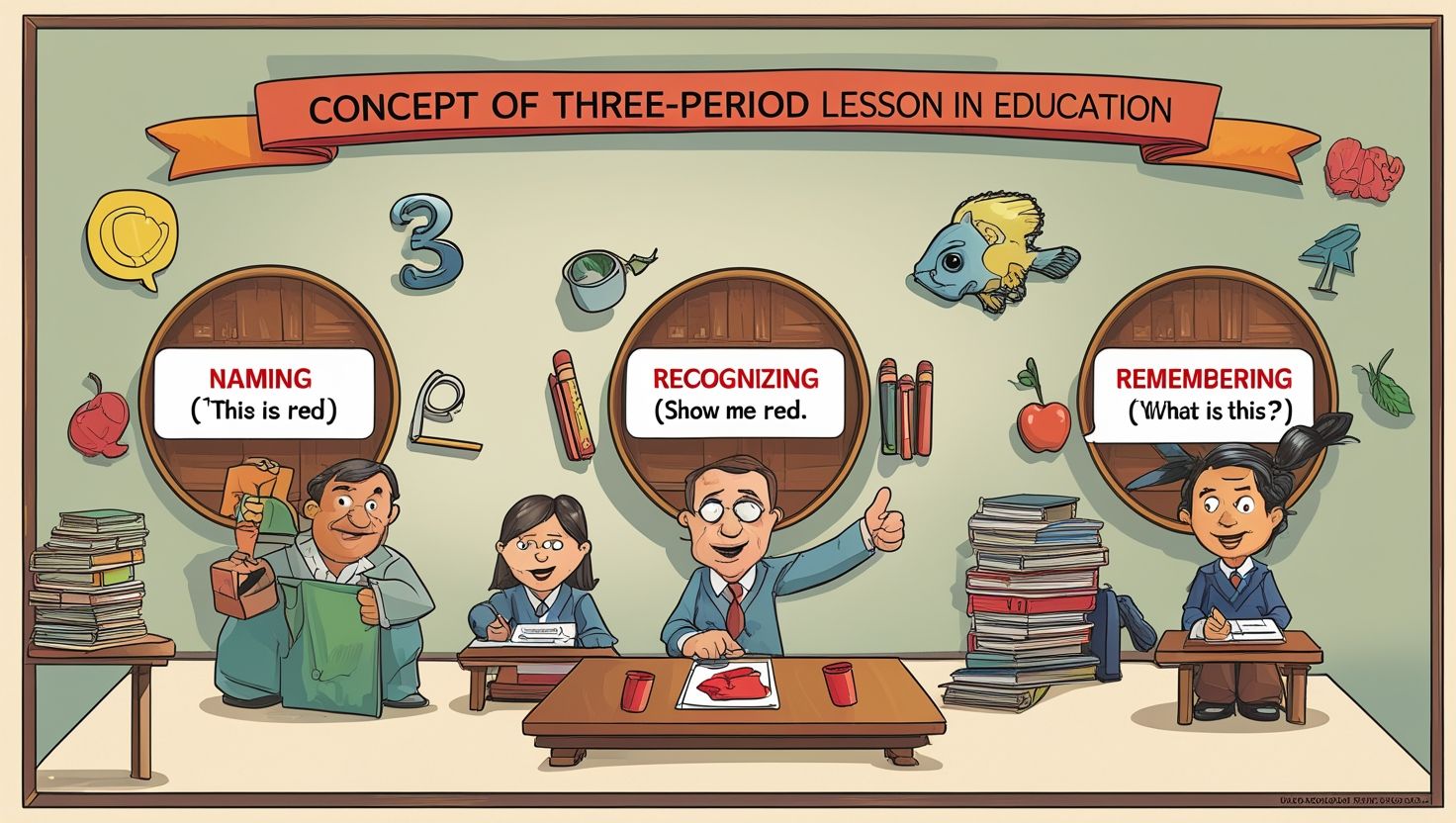Introduction
Concept of Three Period Lesson in Education, The Three Period Lesson is a well-known instructional strategy in Montessori education. It was first developed by Dr. Maria Montessori, drawing from earlier pedagogical influences. This method is designed to help children learn vocabulary, concepts, and skills in a clear and sequential way. The lesson is divided into three distinct periods. These periods guide the learner from initial recognition to independent recall. This structured approach encourages active participation and self-correction.
In the first period, the teacher introduces new information. The focus is on naming and associating. In the second period, the learner practices identifying and distinguishing concepts. This stage is interactive and encourages repetition. The third period checks the learner’s ability to recall without prompts. This sequence allows gradual transition from guided learning to independent mastery.
Moreover, the Three Period Lesson is highly adaptable. Teachers can use it for vocabulary development, concept formation, and even mathematics. The method respects the pace of individual learners. It promotes observation, patience, and trust in the child’s learning process. Because of its simplicity and effectiveness, the Three Period Lesson remains a cornerstone of Montessori methodology. Understanding this concept provides educators with a timeless tool for enhancing comprehension and retention in diverse classroom settings.
Historical Background of the Three Period Lesson
The origin of the Three Period Lesson dates back to the late 19th and early 20th centuries. It was influenced by the work of French physician Edouard Séguin, who used structured lessons for children with defferent needs. Dr. Maria Montessori, inspired by Séguin’s ideas, refined the approach. She adapted it for all children, focusing on independence and self-directed learning. This transformation made it a central element in Montessori classrooms worldwide.
In Montessori’s time, education often relied on rote memorization. The Three Period Lesson provided a fresh alternative. It respected the child’s natural curiosity. Instead of memorizing without context, children learned through association, practice, and recall. This method ensured deeper understanding. It also helped children build confidence as they progressed through each stage.
Over time, the lesson became a key technique for teaching vocabulary and classification. Montessori educators found it effective for teaching language, geography, math, and science concepts. The simplicity of its structure made it easy to adapt to various subjects. Historical use shows that it bridges the gap between introduction and mastery.
Today, the Three Period Lesson is not limited to Montessori settings. Teachers in various educational environments use it to support differentiated learning. Its historical roots remind us of its enduring value. This method has proven its adaptability and relevance for more than a century.

Structure of the Three Period Lesson
The Three Period Lesson follows a clear and logical structure. Each period has a distinct purpose. The first period is known as the “Naming” phase. Here, the teacher introduces new material. For example, the teacher may present three objects and name each clearly. The child listens and observes. The focus is on introducing accurate terminology and linking it with concrete objects or concepts.
The second period is the “Recognition” or “Association” phase. This is the most interactive stage. The teacher prompts the learner with questions such as, “Can you show me the apple?” or “Where is the triangle?” The learner responds by identifying the correct object. This phase reinforces understanding. It also provides opportunities for repetition and correction in a supportive environment.
The third period is the “Recall” phase. In this stage, the teacher asks the learner to name the object without prompts. For example, the teacher might point to an object and say, “What is this?” This checks independent recall and mastery of the concept.
This structured progression from introduction to recall ensures clarity. The learner moves gradually from passive observation to active application. Each period builds on the last, making the process effective. The structure encourages self-confidence, as learners experience success at each stage. It also helps educators monitor progress easily.
Period One: Naming and Introduction
The first period of the Three Period Lesson is essential. It introduces the learner to new information in a simple and direct way. The teacher presents an object, image, or concept. They clearly name it, using correct pronunciation and tone. For example, the teacher might show a picture of a “cat” and say, “This is a cat.” Repetition ensures that the child hears and associates the name accurately.
During this stage, the child’s role is primarily observational. They listen and absorb the information without pressure to respond. The teacher may introduce two or three items at a time. This prevents overload and keeps focus sharp. The goal is to create a clear mental link between the object and its name.
Transitions between examples are smooth. For instance, after introducing “cat,” the teacher may move to “dog,” maintaining the same clear and calm approach. Visual and tactile aids are often used. These make the introduction more engaging and memorable.
Importantly, the teacher observes the child’s reactions. If signs of confusion appear, the pace is adjusted. This first period sets the foundation for all further learning in the lesson. Without a strong introduction, later recall will be harder. Therefore, precision and patience are key during this stage.

Period Two: Recognition and Association
The second period is often the most extended part of the lesson. It focuses on recognition and association. Here, the teacher checks if the child can connect the new name with the correct object. The teacher uses prompts like, “Show me the cat,” or “Point to the dog.” The child responds by selecting or touching the right item. This interaction confirms understanding.
During this phase, repetition plays an important role. The teacher may vary the order of requests to strengthen memory. They might also introduce small challenges, such as mixing up the objects. This encourages the learner to think carefully before responding.
The second period also allows for natural correction. If the child makes an error, the teacher gently repeats the correct term. They may reintroduce the object’s name to reinforce learning. Because this stage is interactive, it helps keep the child engaged.
Transitions are used to maintain interest. For example, the teacher might add a small movement game or change the tone of voice. These techniques make the practice more dynamic. By the end of this period, the learner should reliably recognize each item when prompted. This recognition is the bridge to independent recall in the next stage.
Period Three: Recall and Mastery
The third period tests mastery of the concept. At this stage, the teacher points to an object and asks, “What is this?” The goal is for the learner to recall and say the name without assistance. This requires the child to retrieve the information from memory. Successful recall indicates that learning is complete for that concept.
This stage is shorter than the recognition phase. However, it is equally important. It demonstrates whether the learner can independently use the vocabulary. If the learner struggles, the teacher may return to earlier periods for reinforcement. This flexibility ensures that the child progresses at their own pace.
Transitions are gentle. If the child answers correctly, the teacher offers positive reinforcement. If not, the teacher avoids pressure and simply reintroduces the material. This maintains the learner’s confidence and interest.
The third period is also where the concept is solidified. The learner now has the ability to both recognize and recall the term. This mastery prepares them for applying the knowledge in broader contexts. It also builds the habit of active retrieval, which is essential for long-term memory retention.
Benefits of the Three Period Lesson
The Three Period Lesson offers many educational benefits. First, it provides a structured framework for introducing new information. This makes learning organized and predictable. Second, it promotes active engagement. The learner moves from passive listening to active recall. This dynamic process strengthens memory.
Another benefit is adaptability. Teachers can use the method for a wide range of subjects. It works equally well for teaching colors, shapes, geography terms, or scientific vocabulary. Additionally, it respects individual learning speeds. Because each period can be repeated, learners are never forced to move on before they are ready.
The method also fosters independence. By the third period, learners can recall information without prompts. This builds self-confidence. The gradual approach reduces stress and creates a supportive environment. Furthermore, the interactive nature of the lesson strengthens the teacher-student relationship. The constant observation and feedback help the teacher tailor the lesson to the learner’s needs.
Finally, the Three Period Lesson aligns with how the brain naturally acquires and stores knowledge. It reinforces the connection between sensory experience, association, and recall. This makes it a powerful tool for both early childhood education and adult learning contexts.

Applications in Montessori and Beyond
While the Three Period Lesson is central to Montessori education, its applications go far beyond it. In Montessori classrooms, teachers use it to teach vocabulary, mathematics, science, and geography. The tactile and visual components make it effective for young learners. It fits perfectly with Montessori’s emphasis on concrete materials before abstract thinking.
In traditional classrooms, teachers can adapt the method to suit their style. For example, in language learning, it can help students acquire new words and grammar structures. In science, it can introduce terms for parts of plants or elements in the periodic table. The clear structure helps learners build solid foundations before moving to complex topics.
Outside formal education, parents can use it at home. It is useful for teaching toddlers everyday vocabulary or for supporting children with learning difficulties. The approach is also adaptable to adult education. Language instructors often use a similar sequence when teaching new vocabulary.
This versatility shows the method’s universal value. Whether in a Montessori preschool, a public school, or an adult language class, the Three Period Lesson provides a proven way to introduce, reinforce, and master new concepts effectively.
Challenges and Limitations
Although the Three Period Lesson is effective, it has challenges. One limitation is the time required. The method is most effective when each period is given enough attention. Rushing through the stages can reduce retention. In large classrooms, giving individual attention to each student can be difficult.
Another challenge is overreliance on the method. While it is powerful, it should be part of a broader teaching toolkit. Some learners may prefer different instructional styles. Teachers must remain flexible and responsive.
In addition, the method depends heavily on the teacher’s observation skills. If a teacher fails to notice signs of confusion, learners may struggle silently. The need for patience and repetition can also be demanding for educators.
Finally, the Three Period Lesson works best for concrete concepts. Abstract ideas may require additional strategies. Despite these challenges, with proper adaptation, the method remains valuable. Teachers must balance its use with other approaches. By doing so, they can overcome limitations while preserving its core benefits.
Concept of Three-Period Lesson
The three-period lesson, developed by Dr. Montessori, is a structured teaching method:
- Naming – The teacher introduces a concept (e.g., “This is red”).
- Recognizing – The student identifies it (e.g., “Show me red”).
- Remembering – The student recalls it independently (e.g., “What is this?”).
This progressive approach ensures comprehension through repetition, active engagement, and reinforcement, making learning effective and lasting.
Conclusion
The Three Period Lesson is a timeless educational method. It moves learners from introduction to recognition and finally to recall. This structured approach supports clear understanding and lasting retention. Rooted in Montessori philosophy and influenced by earlier educators, it continues to prove its effectiveness.
Its benefits are clear. It promotes active engagement, builds confidence, and adapts to multiple subjects. While challenges exist, these can be managed with flexibility and careful observation. The method’s adaptability ensures it can be applied in Montessori, traditional classrooms, and even at home.
Ultimately, the Three Period Lesson is more than a teaching technique. It reflects a philosophy of patient, respectful, and individualized learning. By understanding and applying it, educators can create learning experiences that are both effective and enjoyable. Its enduring relevance is a testament to its thoughtful design and its respect for the natural learning process.

9coxs7
elfgaj
Greetings! I’ve been reading your website for some tike now and finally got the bravery to go
ahead and give you a shout out from Kingwood Tx! Just wanted
to say keep up the good job! https://Hot-Fruits-Glassi.Blogspot.com/2025/08/hot-fruitsslot.html